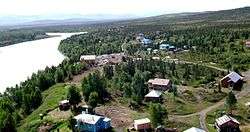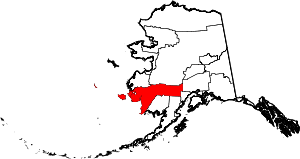Lime Village, Alaska
| Lime Village, Alaska | |
|---|---|
| CDP | |
 | |
|
Location of Lime Village, Alaska | |
| Coordinates: 61°20′29″N 155°29′27″W / 61.34139°N 155.49083°WCoordinates: 61°20′29″N 155°29′27″W / 61.34139°N 155.49083°W | |
| Country | United States |
| State | Alaska |
| Census Area | Bethel |
| Government | |
| • State senator | Lyman Hoffman (D) |
| • State rep. | Bryce Edgmon (D) |
| Area | |
| • Total | 82.5 sq mi (213.6 km2) |
| • Land | 80.3 sq mi (207.9 km2) |
| • Water | 2.2 sq mi (5.7 km2) |
| Population (2010) | |
| • Total | 29[1] |
| • Density | 0.1/sq mi (0.0/km2) |
| Time zone | Alaska (AKST) (UTC-9) |
| • Summer (DST) | AKDT (UTC-8) |
| Area code(s) | 907 |
| FIPS code | 02-44030 |
| GNIS ID | 2418687[2] |
Lime Village is a census-designated place (CDP) in Bethel Census Area, Alaska, United States. The 2010 census found a population of 29. It has also been known as Hungry Village and Hek'dichen Hdakaq'
In July 2008, Lime Village gained notoriety [3] when it was reported that their gasoline prices were more than double of the already-high national average of over $4/gallon with Lime Village selling regular unleaded gasoline at $8.55/gallon. The high prices were considered ironic considering that Alaska is one of the main suppliers of oil in the United States, but have the highest state average due to scattered villages throughout Alaska such as Lime Village making it difficult to transport oil and other goods.
Geography
Lime Village is located at 61°20′29″N 155°29′27″W / 61.34139°N 155.49083°W (61.341383, -155.490944).[4]
According to the United States Census Bureau, the CDP has a total area of 82.5 square miles (214 km2), of which, 80.3 square miles (208 km2) of it is land and 2.2 square miles (5.7 km2) of it (2.67%) is water.
Demographics
As of the census of 2010, there were 29 [1] people and 11 households. The population density was 0.1 people per square mile (0.0/km²). There were 24 housing units at an average density of 0.3/sq mi (0.1/km²). The racial makeup of the CDP was 3.7% White, and 96.3% from one race.
School
The Lime Village School closed in 2007,[5] when the enrollment of six students failed to meet the state-mandated minimum of ten students. As of Fall 2008 the school remained closed. The lack of access to local schooling has increased urban migration, though many migrants continue to spend summers in the village.
References
- 1 2 http://factfinder2.census.gov/faces/nav/jsf/pages/index.xhtml
- ↑ U.S. Geological Survey Geographic Names Information System: Lime Village, Alaska
- ↑ "Alaska Suffers From Highest U.S. Gas Prices". Autoblog.com.
- ↑ "US Gazetteer files: 2010, 2000, and 1990". United States Census Bureau. 2011-02-12. Retrieved 2011-04-23.
- ↑ http://juneauempire.com/stories/121407/sta_20071214028.shtml
